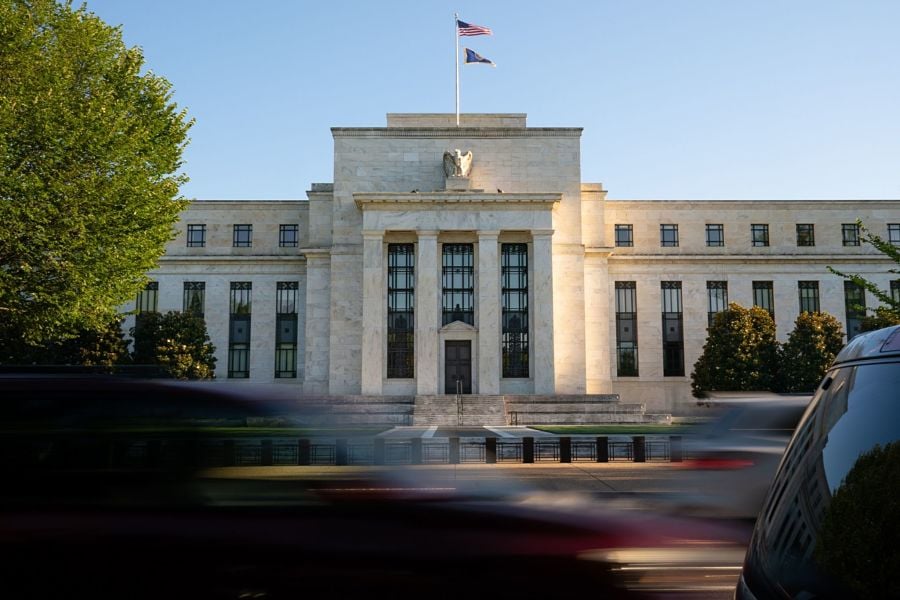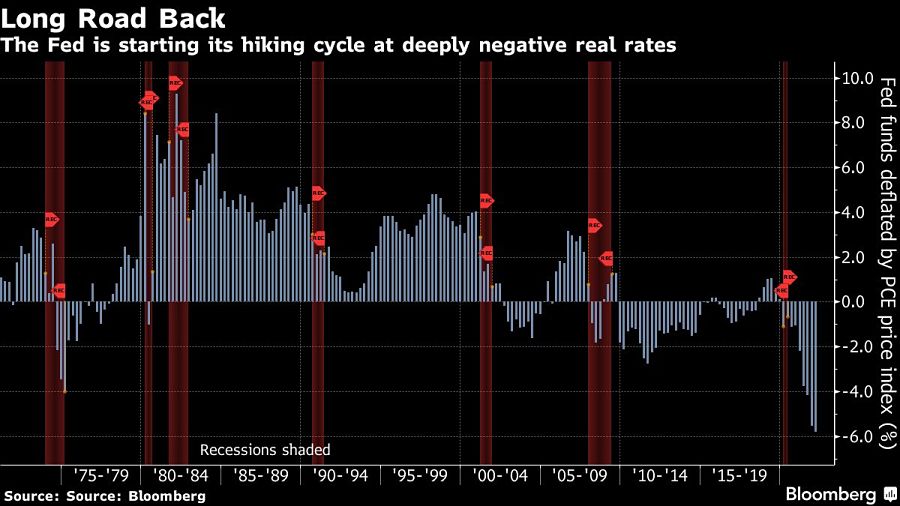

The Federal Reserve will begin a multi-month campaign of rate hikes to conquer inflation this week that could see Chair Jerome Powell moving even more aggressively after Russia’s war on Ukraine fanned prices further.
Already pivoting to tightening monetary policy amid the fastest consumer price gains in four decades, Powell and colleagues now have to deal with the economic fallout of the war, which threatens to deliver the twin blows of weaker growth and even quicker inflation.
With a 25 basis-point hike almost certain on Wednesday after Powell took the rare step of publicly backing such a shift, futures markets show around 165 basis points of tightening this year, or the equivalent of at least six quarter-point increases.

There’s certainly reason to be worried about inflation as Russia’s invasion compounds the pressures ignited by the pandemic. The cost of food, fuel and metals has soared since the war began, with gasoline alone at a record, while prices for many services were already higher.
Eyeing the first rate increase since 2018, Powell has been given license to be hawkish by President Joe Biden, lawmakers across the political spectrum and many fellow Fed officials, as businesses and households become increasingly anxious to avoid the harm of 1970s-style price shocks that crimp their spending power.
“Powell can’t really afford to be dovish at this point, it would be inconsistent with what sound policy is and where policy needs to be heading,” said Derek Tang, an economist at Monetary Policy Analytics in Washington.
While Powell has argued the Fed will be nimble, his post-decision press conference on Wednesday will be parsed for clues as to how high rates could ultimately go from around zero today and how quickly officials may move to get there. Goldman Sachs Group Inc. predict officials will eventually stop raising rates at 3% sometime next year.
A key insight will be provided by the Fed’s dot plot of rate projections through 2024 and how much Powell endorses it.
Last week’s meeting of the European Central Bank showed the potential for hawkish surprises when President Christine Lagarde announced a more accelerated wind-down of monetary stimulus. The Bank of England is also set to lift rates this week for a third straight meeting.

U.S. central bankers start their tightening campaign with real interest rates — nominal rates adjusted for inflation — at the most deeply negative level going back to the 1970s. If longer-run inflation expectations rise, that means there could be more road to cover to get policy to a more neutral setting that neither speeds up nor slows down growth, even as the conflict makes the route harder to discern.
“This is a real mess,” said Tim Duy, chief U.S. economist at SGH Macro Advisors, who sees risks from higher inflation dominating the danger of slower growth.
“Powell would like to thread the needle, such that we maintain strong growth yet get inflation back to something more reasonable,” Duy said. “If he can do this, he is a legend.”
That puts the focus on whether Powell signals a tack toward a more hawkish or easier path of tightening, or keeps his options open by talking about the need for flexibility amid uncertainty.
It’s not an easy call. Forecasters expect the economy to slow this year with fiscal spending shrinking, and a University of Michigan survey last Friday showed consumer sentiment falling to the lowest since 2011 following the spike in fuel costs and inflation, which doesn’t bode well for spending.
Fed officials will also want to see how their balance-sheet runoff plans impact financial conditions, which have tightened further in the wake of the war. They’re expected to announce the pace at which they plan to shrink the balance sheet at this meeting, though they’ve yet to set a date for the process to commence.
A sharp slowdown in the level of hiring would argue to reduce the pace of tightening.
Powell “has made it clear, they are going to move steadily to neutral,” said Julia Coronado, founder of MacroPolicy Perspectives. “The resilience of demand will be the leading indicator” of how fast they go.
At the same time, the Fed has a mission to keep prices stable, and patience is wearing thin both inside and outside the central bank.

Powell heard from lawmakers on both sides of the aisle earlier this month that their constituents want action on inflation. And his own committee has taken a more hawkish tilt.
St. Louis Fed President James Bullard, a policy voter this year, has called for “rapid withdrawal of policy accommodation,” while Fed governor Christopher Waller has said he wants at least 100 basis points of tightening by mid-year, with a half-point hike an option. Governor Michelle Bowman said she's prepared to take “forceful action” to bring inflation back to goal.
No Fed official is talking about tilting the economy into a recession to control inflation. But their ability to be patient is only limited by public confidence in their ability to return inflation to about 2% a year.
“Given the surge in commodity prices, inflation expectations are at a perilous point right now,” said Sarah House, senior economist at Wells Fargo & Co.. “They’re not above the Fed’s target but they’re perilously close. That’s going to keep the Fed’s plan to hike on track.”

President meets with ‘highly overrated globalist’ at the White House.

A new proposal could end the ban on promoting client reviews in states like California and Connecticut, giving state-registered advisors a level playing field with their SEC-registered peers.

Morningstar research data show improved retirement trajectories for self-directors and allocators placed in managed accounts.

Some in the industry say that more UBS financial advisors this year will be heading for the exits.

The Wall Street giant has blasted data middlemen as digital freeloaders, but tech firms and consumer advocates are pushing back.
Orion's Tom Wilson on delivering coordinated, high-touch service in a world where returns alone no longer set you apart.
Barely a decade old, registered index-linked annuities have quickly surged in popularity, thanks to their unique blend of protection and growth potential—an appealing option for investors looking to chart a steadier course through today's choppy market waters, says Myles Lambert, Brighthouse Financial.
